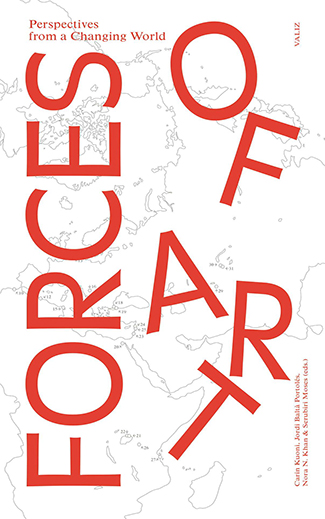Forces of Art Ebook
Perspectives from a Changing World

- Reflects on the transforming power of art in communities in the global south
- An extensive volume with many case studies and research conducted by people from different regions, rather than written about them
Editors: Carin Kuoni, Jordi Baltà Portolés, Nora N. Khan & Serubiri Moses
Contributors: Mariam Abou Ghazi, Kobina Ankomah-Graham, Jordi Baltà Portolés, Ilka Eickhof, Fernando Escobar Neira, Fatin Farhat Maya Indira Ganesh, Rocca Holly-Nambi, Miranda Jeanne Marie Iossifidis, Nuraini Juliastuti, Nora N. Khan, Višnja Kisić, Diana T. Kudaibergenova, Carin Kuoni, Kabelo Malatsie, Jenny Mbaye, Zayd Minty, Nadia Moreno Moya, Serubiri Moses Judith Naeff, Laura Nkula-Wenz, Joseph Oduro-Frimpong, Arnout van Ree, Naomi Roux, Vaughn Sadie, Anna Selmeczi Nishant Shah, Lenneke Sipkes, Rike Sitas, Cristiana Strava, Goran Tomka, Kasper Tromp, Minna Valjakka, Paulina E. Varas Mark R. Westmoreland, Kitty Zijlmans
Design: Lu Liang
Valiz together with Prince Claus Fund for Culture and Development, Hivos, European Cultural Foundation | 456 pp | English | November 2020 | ISBN 978-94-92095-99-2 | € 12,50
Forces of Art investigates the way in which artists, artworks and cultural organizations affect people and their social environments, and explores how cases of creative practice have been operational in empowering people, communities, and societies in their given contexts. It is a dense, multi-layered, polyvocal compendium of current thinking about the impact of art on civil society and social change, and contains a large number of essays and case studies located all over the world, from Central Asia to Meso and Latin America, from Africa to Central Europe, from South and South-East Asia to the Middle East. The driving force is the shared concern and responsibility for societies worldwide, with regards to culture and the well-being of its communities. Considering the question of how art can be consequential, the book challenges the reader to think beyond art as representation, as merely aesthetical, or as simply an object or commodity. Instead, it stirs thinking of art in terms of a force that has the ability to transform.
